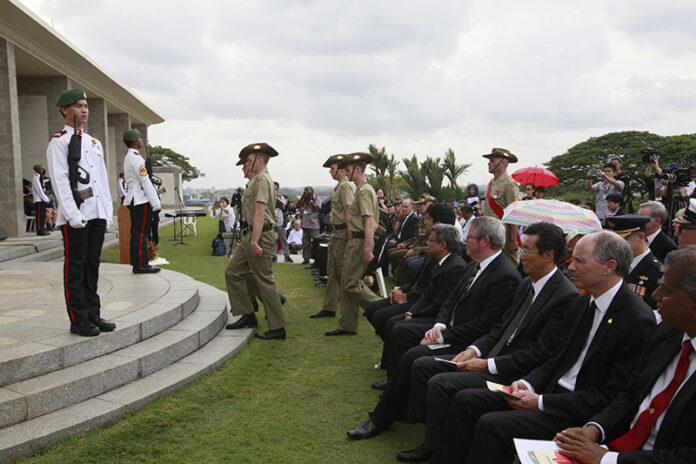
SINGAPORE — It was 75 years ago that Singapore, the island at the tip of the Malay Peninsula that had been key strategic outpost of Britain’s colonial empire, fell to invading Japanese troops. The events live on in history books more than in memories. But for Margaret Menz, the passage of years has not dulled the pain.
Menz, 84, was among hundreds of people who attended a commemoration Wednesday at Singapore’s Kranji War Cemetery. World War II veterans, family members and officials said prayers, observed a period of silence and laid wreaths in memory of lives lost. As a sign of respect, Japanese Ambassador Kenji Shinoda laid a wreath. Students from a local Japanese school contributed paper cranes.
The cemetery hosts more than 4,400 white gravestones marking the final resting places of soldiers from countries such as Britain, Australia and New Zealand who died for a hopeless cause, led by overconfident commanders fighting an overwhelming invading force.
Among the stones lies Menz’s brother, James Francis McGrath. The Australian signalman died after being hit by Japanese shrapnel.
“Heartbreaking and so sad,” Menz said. “What was it all for? It should have never happened.”
Singapore’s days as a British colony were numbered when Japanese troops started to move swiftly down the Malay Peninsula in early 1942. The British greatly underestimated the fighting prowess of their enemy, and Japanese forces controlled the air and surrounding seas as well.
It was on Feb. 15, 1942, after a week of fierce, last-ditch fighting, that British Lt.-Gen. Arthur Ernest Percival surrendered Singapore and hostilities ceased. The occupation would prove to be a rough one, causing hardship and suffering for Singaporeans and prisoners of war alike.
About 15,000 Australian prisoners of war from the 8th Division, captured in the sweep down the peninsula, “endured some incredible brutality during that time,” Vice Adm. Ray Griggs, vice chief of Australia’s Defense Force, said Wednesday.
Many attendees at the ceremony were Australians who made a special trip to pay respects to family members.
“It’s still very emotional for me,” said Barry Cawley, 84, who lost his brother.
“The last thing he did before he went off to go to Singapore … he came to me at my school, I was in about Grade 1, and gave me a hug. That was the last time I saw him,” he said.
Wayne Joseph, 65, attended the ceremony with eight medals for honorable service pinned to his chest. They belonged to his father, a former prisoner of war who survived building the “Death Railway.” The project, begun by the Japanese to link Thailand with Burma – now called Myanmar – was immortalized in the novel and 1957 feature film “The Bridge on the River Kwai.”
The endeavor in western Thailand’s sweltering, malaria-infested jungles cost the lives of more than 100,000 Allied prisoners and Asians enslaved by Japan’s Imperial Army.
“It has been a long time. But people shouldn’t forget what they went through to give us the freedom that we’ve got today. They died for a cause,” Joseph said.
New Zealand High Commissioner Jonathan Austin related the costly struggle of 75 years ago to contemporary challenges.
“I think we live in a very uncertain world. Events that we see in the news every day remind us of that, whether it’s challenges to our natural resources or terrorism,” he said. “It’s going to be important that none of us forget the sacrifices that our servicemen and women have made in the past so that we can all enjoy the freedom and prosperity that we have today.”
















































